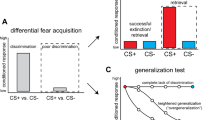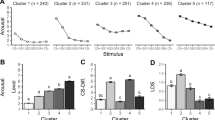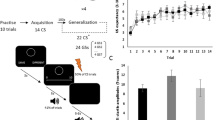Abstract
Broad generalization of negative memories is a potential etiology for anxiety disorders, yet the underlying mechanisms remain unknown. We developed a non-human primate model that replicates behavioral observations in humans and identifies specific changes in tuning properties of amygdala neurons: the width of auditory tuning increases with the distance of its center from the conditioned stimulus. This center-width relationship can account for better detection and at the same time explain the wide stimulus generalization.
This is a preview of subscription content, access via your institution
Access options
Subscribe to this journal
Receive 12 print issues and online access
$209.00 per year
only $17.42 per issue
Buy this article
- Purchase on Springer Link
- Instant access to full article PDF
Prices may be subject to local taxes which are calculated during checkout



Similar content being viewed by others
References
Pitman, R.K. et al. Nat. Rev. Neurosci. 13, 769–787 (2012).
Lissek, S. Depress. Anxiety 29, 257–263 (2012).
Jovanovic, T. & Ressler, K.J. Am. J. Psychiatry 167, 648–662 (2010).
Aizenberg, M. & Geffen, M.N. Nat. Neurosci. 16, 994–996 (2013).
Resnik, J., Sobel, N. & Paz, R. Nat. Neurosci. 14, 791–796 (2011).
Laufer, O. & Paz, R. J. Neurosci. 32, 6304–6311 (2012).
Duvarci, S. & Pare, D. Neuron 82, 966–980 (2014).
Armony, J.L., Servan-Schreiber, D., Romanski, L.M., Cohen, J.D. & LeDoux, J.E. Cereb. Cortex 7, 157–165 (1997).
Shaban, H. et al. Nat. Neurosci. 9, 1028–1035 (2006).
Han, J.H. et al. Learn. Mem. 15, 443–453 (2008).
Quirk, G.J., Armony, J.L. & LeDoux, J.E. Neuron 19, 613–624 (1997).
David, S.V., Fritz, J.B. & Shamma, S.A. Proc. Natl. Acad. Sci. USA 109, 2144–2149 (2012).
Likhtik, E. & Stujenske, J.M. Nat. Neurosci. 17, 106–113 (2014).
Chavez, C.M., McGaugh, J.L. & Weinberger, N.M. Neurobiol. Learn. Mem. 91, 382–392 (2009).
Dunsmoor, J.E., Prince, S.E., Murty, V.P., Kragel, P.A. & LaBar, K.S. Neuroimage 55, 1878–1888 (2011).
Courtin, J. et al. Nature 505, 92–96 (2014).
Xu, W. & Sudhof, T.C. Science 339, 1290–1295 (2013).
Bergado-Acosta, J.R. et al. Learn. Mem. 15, 163–171 (2008).
Kaouane, N. et al. Science 335, 1510–1513 (2012).
Johansen, J.P., Tarpley, J.W., LeDoux, J.E. & Blair, H.T. Nat. Neurosci. 13, 979–986 (2010).
Livneh, U. & Paz, R. J. Neurosci. Methods 192, 90–95 (2010).
Livneh, U. & Paz, R. J. Neurosci. 32, 8598–8610 (2012).
Livneh, U. & Paz, R. Neuron 75, 133–142 (2012).
Paton, J.J., Belova, M.A., Morrison, S.E. & Salzman, C.D. Nature 439, 865–870 (2006).
Balleine, B.W. & Killcross, S. Trends Neurosci. 29, 272–279 (2006).
Herry, C. et al. Nature 454, 600–606 (2008).
Sangha, S., Chadick, J.Z. & Janak, P.H. J. Neurosci. 33, 3744–3751 (2013).
Genud-Gabai, R., Klavir, O. & Paz, R. J. Neurosci. 33, 17986–17994 (2013).
Moore, A.K. & Wehr, M. J. Neurosci. 33, 13713–13723 (2013).
Bordi, F. & LeDoux, J. J. Neurosci. 12, 2493–2503 (1992).
Ciocchi, S. et al. Nature 468, 277–282 (2010).
Bartlett, E.L., Sadagopan, S. & Wang, X. J. Neurophysiol. 106, 849–859 (2011).
Cover, T.T., Thomas, J.A. Elements of Information Theory (Wiley-Interscience, 1991).
Seung, H.S. & Sompolinsky, H. Proc. Natl. Acad. Sci. USA 90, 10749–10753 (1993).
Salinas, E. & Abbott, L.F. J. Comput. Neurosci. 1, 89–107 (1994).
Acknowledgements
We are grateful to H. Sompolinsky for discussions and suggestions. We thank Y. Shohat for major contribution to the work and welfare of the animals, E. Kahana and G. Hecht for help with medical and surgical procedures, E. Furman-Haran and N. Stern for magnetic resonance imaging procedures. This work was supported by the Minerva Foundation and the Israel Science Foundation (#26613 and ERC-FP7-StG #281171, R.P.).
Author information
Authors and Affiliations
Contributions
J.R. and R.P. designed the research. J.R. performed the experiments. J.R. analyzed the data. J.R. and R.P. wrote the paper.
Corresponding author
Ethics declarations
Competing interests
The authors declare no competing financial interests.
Integrated supplementary information
Supplementary Figure 1 Behavioral generalization.
a. Behavioral generalization curves in four Individual sessions. Shown is the conditioned response (CR, mean ± SEM), as a function of absolute (main) or real (inset) distance from CS.
The preparatory conditioned-response (CR) is the change in the inhale that triggers the CS tone, i.e. before the inhale that triggers odor release – hence a preparatory response, and quantified as the half-height-time of the inhale in ms. It is then normalized within session to account for differences across days.
b. The width of behavioral generalization (i.e. the half-height width from Fig.1e), but computed separately for the first third of recording sessions, the 2nd, and the last 3rd (mean±SEM). This shows that the behavioral generalization was similar along the experimental period (p>0.1, ANOVA).
c. Behavioral generalization, similar to main Fig.1e but here the CR is quantified as the peak of the preparatory inhale (mean ± SEM).
d. Same as Fig.1g when the CR is quantified as the peak as in (c) (significant difference between aversive and pleasant response).
e. Same as Fig.1h when the CR is quantified as the peak as in (c). The just-noticeable-difference (JND, 70.7% of the maximal response) computed here was 6.9%.
Supplementary Figure 2 Examples of tuning curves in the amygdala.
a. Two examples of single-cells’ tuning curves. The middle panel shows the firing rate as a function of the nine presented tones in the generalization phase (mean ± SEM). Outer panels show raster plots overlaid by PSTH of individual responses to each tone.
b. Three additional examples of single-cells’ tuning curves: firing rate as a function of the nine presented tones in the generalization phase (mean ± SEM, dots indicate FR in individual trials). Insets show the same generalization curves but as a function of absolute distance from the CS (mean ± SEM).
Supplementary Figure 3 Tuning-width changes with preferred-stimulus post-conditioning, but not pre-conditioning.
a. Change in tuning width (width in post- minus pre-conditioning, mean±SEM) as a function of PS distance from CS (p=0.03, F=2.96, ANOVA). This suggests that neurons generally had wide tuning pre-conditioning and narrowed/widened their tuning with direct relationship to the distance of their post-conditioning PS from the CS.
b. The same analysis using PS from pre-conditioning showed no relationship (p=0.92 F=0.16 ANOVA).
c. Tuning width during post-conditioning generalization as a function of the PS in the pre-conditioning habituation (phase/tone/interaction p=0.25/0.76/0.59 F=1.33/0.39/0.63, 2-way ANOVA).
d. Same as in Fig.2e, but with width of tuning from pre-conditioning habituation (r=0.17, p=0.95, Pearson).
Supplementary Figure 4 There were no changes in tonic activity of BLA neurons.
Firing rate during the pre-conditioning (habituation) plotted against the firing rate in the post-conditioning (generalization) phase for each neuron. Insets show the overall average in both phases (mean ± SEM). Left: activity taken from 1 sec before the tones and represents baseline activity. Right: activity taken from 1 sec after the tone and represents evoked response. There was no change in tonic responses (p=0.829 for left and 0.724 for right, paired t-test).
Supplementary Figure 5 Additional characteristics of tuning in the post-learning phase.
a. Correlation between Gaussian fit (R2) and the absolute distance between the PS and the CS during generalization (r=-0.137, p=0.046; during habituation: r=-0.01, p=0.92). The slightly better fit for neurons with PS closer to the CS can reflect the narrower tuning described.
b. Distribution of PS in pre- and post-conditioning periods. There was no change in variance of the distributions (right, variance ± CI, p>0.1), indicating that in the current paradigm, neurons did not shift their PS selectively towards the CS.
c. Daily behavioral PS (center of Gaussian fit to the behavioral responses) varied with the neural PS recorded in the same session, but only during post-conditioning phase (left, r=0.38 p=0.005; pre-conditioning: right, r=-0.04 p=0.8).
Supplementary Figure 6 Neurons increase their tuning width rather than adding a CS response.
a. Normalized firing rates for all tones as a function of absolute distance from the CS. Each panel depicts the average over all neurons with PS distance from the CS in a specific range (indicated in the color legend). All curves have a single peak at the PS, rather than a double peak at the PS and at the CS.
b. Difference in (normalized) firing rate between the PS segment and the segment next to it, for the four groups of neurons as in (a). Inset shows the slope of these lines. The closer the PS to the CS, the steeper the slope (p<0.001, F=7.7, ANOVA). This strengthens the main finding, of narrower curves next to the CS.
Supplementary Figure 7 Basic auditory tuning properties of neurons in the primate amygdala.
Pseudorandomized presentation of 40 pure-tones, ranging 300–4800 Hz (4 octaves) in equal logarithmic steps. Each tone was presented 30 times for 200ms (10ms rise/fall ramp; ITI:200ms).
a. Rater plots overlaid with PSTH for 4 BLA neurons, aligned on tone onset.
b. Auditory STRF for 4 BLA neurons (40 tones spanning 4 octaves in equal logarithmic distance)
c. Distribution of number of peaks showing that most neurons had one best-frequency (BF, n=126). Zero-peaks was defined for broadly un-tuned units that responded equally to the entire tested spectrum. Inset shows the mean firing rate for the three different groups (mean ± SEM)
d. BF distribution from tuned units was homogenous (logarithmic scale, χ2=25.7, p>0.1, n=99)
e. Five examples of single-cells’ tuning. STRFs were averaged over the first 200 ms, and shown either in color scale or as a graph (upper three are 1-peak, fourth is 2-peak, lower is 0-peak).
f. Distribution of response bandwidths and its cumulative distribution. Median=0.76
g. Latency distribution of response to each unit’s PS. Median=76ms. Notice the relatively large group of neurons with latency of <50ms.
Supplementary Figure 8 Tuning curves with dense homogenous sampling and following 24 h.
a. Ten examples of single-cells’ tuning curves, evaluated by presentation of 40 different tones spanning 4 octaves (300 Hz to 4800 Hz) with equal spacing in logarithmic scale, and each tone is presented 10 times for 200ms in pseudorandom order.
Shown is the firing rate, either in a colormap (bottom) or on the y-axis, as a function of distance (%) from the CS+ of the previous day.
From top to bottom: the further the PS is from the CS+ of the previous day, the wider the tuning.
Hence, even with dense homogenous sampling, the characterization of tuning curve show the same attribute of width as a function of distance from the CS+. Moreover, this is evident even in the following day before a new session begins, indicating correlates of overnight memory.
b. Correlation between the width of the tuning curves (in octaves) and the distance between the neuron’s PS and the CS+ from the previous day (solid line, p<0.01, r=0.5). As control, we repeated this analysis using random tones as the CS+ (1000 repetitions, dashed line, mean ± SEM).
c. Distribution of PS was homogenous.
Supplementary Figure 9 Robustness of relationship between width and PS distance from CS.
a. Linear regression between tuning-width and PS distance from CS for neurons with different tuning fits. From left to right: for neurons with tuning-fit of R2 > 0.1, >0.2, >0.3, >0.5, >0.6; R2>0.4 is shown in main Fig.2e. All regressions were significant with similar coefficients.
b. The slope between the PS and the tuning-width, separately for the 1st third of the recording epoch, the 2nd, and the final third; showing similar neural changes following conditioning along the recording period.
Supplementary Figure 10 Behavioral and neural dynamics during conditioning and post-learning.
a. Behavioral conditioned response (CR, the half-height-time of the inhale that triggers the CS, mean±SEM) during the first third of the acquisition trials, the 2nd, and the last third (F=5.16, p=0.002, ANOVA).
b. Neural response (firing rate evoked by the CS, mean±SEM) during the first third of the acquisition trials, the 2nd, and the last third (F=2.76, p=0.04, ANOVA).
c. Comparing rate of change for the neural response vs. the behavioral response on an individual basis (each dot is a neuron in one conditioning session). Upper: by fitting an exponential function to each and plotting λs; Lower: by fitting linear regression and plotting the slope.
Solid lines represent the identity (upper: p=0.3, χ2=1.0; lower: p=0.04, χ2=4.5).
d. Larger response for the CS that decays with distance from it, when counting spikes (left) or number of responding neurons (right). Insets show the same for the surrogate data.
Supplementary Figure 11 Tone discrimination based on neural activity.
a. d’ between the CS and other tones, averaged over all neurons (top: experimental data; bottom: surrogate data), during habituation (grey) and generalization-test (black). This is the same figure as main Fig.3b – inserted here for clarity.
b. Change in d’ for all tone combinations. Color scale represents the difference in d’ from post-conditioning minus the d’ from pre-conditioning. The narrow diagonal band indicates no or negative improvement between near-by tones.
c. To see how this result emerges from the population data, one can calculate the Fisher-Information (FI) for the CS when including neurons with PS farther from the CS and wide tuning curves (here, FI is the normalized average of the tuning-curves’ slope). This validated that information is high when considering only neurons with PS right next to the CS - because they have sharp tuning, hence their slope at the CS is large; but information decays when taking into account neurons with wide generalization curves – because the information they provide is low due to a shallower slope around the CS.
Supplementary information
Supplementary Text and Figures
Supplementary Figures 1–11 (PDF 4180 kb)
Rights and permissions
About this article
Cite this article
Resnik, J., Paz, R. Fear generalization in the primate amygdala. Nat Neurosci 18, 188–190 (2015). https://doi.org/10.1038/nn.3900
Received:
Accepted:
Published:
Issue Date:
DOI: https://doi.org/10.1038/nn.3900
This article is cited by
-
Activation of Beta-adrenergic Receptors Upregulates the Signal-to-Noise Ratio of Auditory Input in the Medial Prefrontal Cortex and Mediates Auditory Fear Conditioning
Molecular Neurobiology (2023)
-
Prolonged contextual fear memory in AMPA receptor palmitoylation-deficient mice
Neuropsychopharmacology (2022)
-
Infralimbic medial prefrontal cortex signalling to calbindin 1 positive neurons in posterior basolateral amygdala suppresses anxiety- and depression-like behaviours
Nature Communications (2022)
-
Altered amygdala effective connectivity in migraine without aura: evidence from resting‐state fMRI with Granger causality analysis
The Journal of Headache and Pain (2021)
-
The association of PTSD symptom severity with amygdala nuclei volumes in traumatized youths
Translational Psychiatry (2020)



